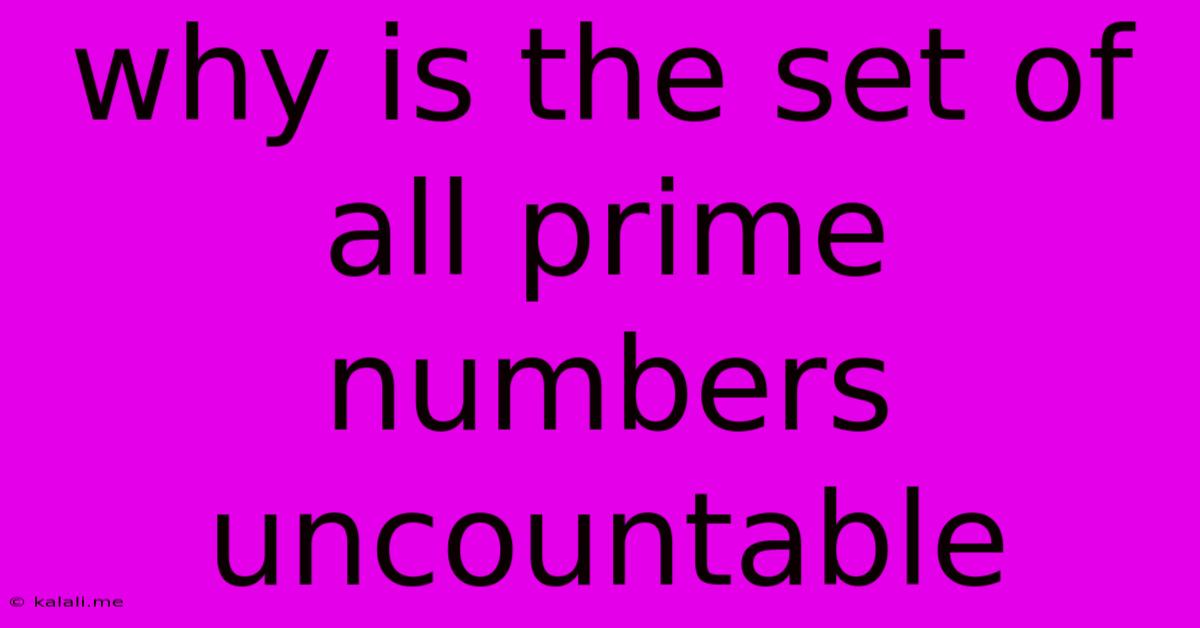Why Is The Set Of All Prime Numbers Uncountable
Kalali
May 23, 2025 · 3 min read

Table of Contents
Why is the Set of All Prime Numbers Uncountable? A Clarification
Meta Description: This article clarifies a common misconception: the set of all prime numbers is not uncountable. It's actually countably infinite, and this article explains why, exploring the concept of countable and uncountable sets along the way.
The statement "the set of all prime numbers is uncountable" is incorrect. The set of all prime numbers is, in fact, countably infinite. This means that while there are infinitely many prime numbers, they can be put into a one-to-one correspondence with the natural numbers (1, 2, 3, 4...). Let's explore why this is the case and address the confusion surrounding countable and uncountable sets.
Understanding Countable and Uncountable Sets
Before we delve into the specifics of prime numbers, let's define what makes a set countable or uncountable.
-
Countable Set: A set is countable if its elements can be listed in a sequence, even if that sequence is infinitely long. This means you can assign a unique natural number to each element in the set. The set of natural numbers itself is a prime example (pun intended!). Other examples include the set of even numbers, the set of integers, and – as we'll demonstrate – the set of prime numbers.
-
Uncountable Set: A set is uncountable if it's impossible to list its elements in a sequence. No matter how you try to order them, you'll always miss some elements. The most famous example of an uncountable set is the set of real numbers. The proof of this involves Cantor's diagonal argument, a fascinating topic in its own right but beyond the scope of this article focused on prime numbers.
The Countability of Prime Numbers
The set of prime numbers is countable because we can list them in a sequence. While there's no finite end to the sequence, the fact that we can create a sequence is what makes it countable. We can simply list them in ascending order:
2, 3, 5, 7, 11, 13, 17, 19, 23, ...
This sequence, although infinite, demonstrates a one-to-one correspondence with the natural numbers. We can assign 1 to 2, 2 to 3, 3 to 5, and so on. Each prime number gets a unique natural number as its index in the sequence. This fulfills the definition of a countable set.
Common Sources of Confusion
The misconception that the set of prime numbers is uncountable might stem from the following:
-
Infinitude: The sheer infinitude of prime numbers can be daunting. It's easy to mistakenly associate infinity with uncountability. However, as we've seen, infinite sets can be either countable or uncountable.
-
Density: Prime numbers become increasingly sparse as you move along the number line. This might lead one to believe that it's impossible to list them systematically. However, the fact remains that a systematic listing is possible, even if the spacing between consecutive primes increases without bound.
Conclusion
In conclusion, the set of all prime numbers is countably infinite. The ability to list the prime numbers in a sequence, however long that sequence may be, is the defining characteristic that places this set firmly within the category of countable sets. Understanding the difference between countable and uncountable sets is crucial in appreciating the richness and complexities of infinity in mathematics.
Latest Posts
Latest Posts
-
Low Pressure Side Of Ac Is High
May 23, 2025
-
Can A Contract Be Null If You Didnt Read It
May 23, 2025
-
Finding The Basis Of The Orthogonal Complement
May 23, 2025
-
Wire For 100 Amp Sub Panel
May 23, 2025
-
How Much Is One Box Of Confectioners Sugar
May 23, 2025
Related Post
Thank you for visiting our website which covers about Why Is The Set Of All Prime Numbers Uncountable . We hope the information provided has been useful to you. Feel free to contact us if you have any questions or need further assistance. See you next time and don't miss to bookmark.